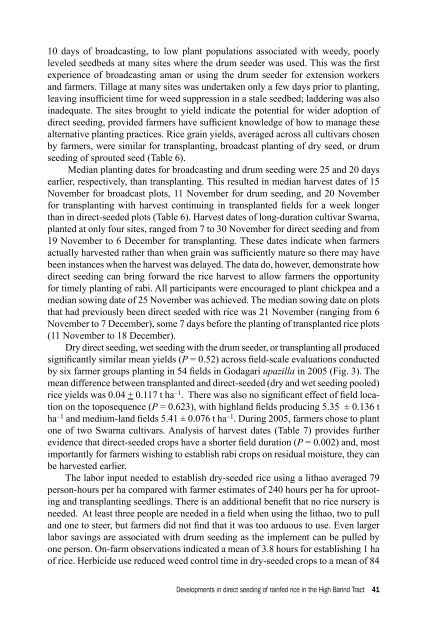Download (2461kB) - University of Greenwich
Download (2461kB) - University of Greenwich
Download (2461kB) - University of Greenwich
- No tags were found...
You also want an ePaper? Increase the reach of your titles
YUMPU automatically turns print PDFs into web optimized ePapers that Google loves.
10 days <strong>of</strong> broadcasting, to low plant populations associated with weedy, poorlyleveled seedbeds at many sites where the drum seeder was used. This was the firstexperience <strong>of</strong> broadcasting aman or using the drum seeder for extension workersand farmers. Tillage at many sites was undertaken only a few days prior to planting,leaving insufficient time for weed suppression in a stale seedbed; laddering was alsoinadequate. The sites brought to yield indicate the potential for wider adoption <strong>of</strong>direct seeding, provided farmers have sufficient knowledge <strong>of</strong> how to manage thesealternative planting practices. Rice grain yields, averaged across all cultivars chosenby farmers, were similar for transplanting, broadcast planting <strong>of</strong> dry seed, or drumseeding <strong>of</strong> sprouted seed (Table 6).Median planting dates for broadcasting and drum seeding were 25 and 20 daysearlier, respectively, than transplanting. This resulted in median harvest dates <strong>of</strong> 15November for broadcast plots, 11 November for drum seeding, and 20 Novemberfor transplanting with harvest continuing in transplanted fields for a week longerthan in direct-seeded plots (Table 6). Harvest dates <strong>of</strong> long-duration cultivar Swarna,planted at only four sites, ranged from 7 to 30 November for direct seeding and from19 November to 6 December for transplanting. These dates indicate when farmersactually harvested rather than when grain was sufficiently mature so there may havebeen instances when the harvest was delayed. The data do, however, demonstrate howdirect seeding can bring forward the rice harvest to allow farmers the opportunityfor timely planting <strong>of</strong> rabi. All participants were encouraged to plant chickpea and amedian sowing date <strong>of</strong> 25 November was achieved. The median sowing date on plotsthat had previously been direct seeded with rice was 21 November (ranging from 6November to 7 December), some 7 days before the planting <strong>of</strong> transplanted rice plots(11 November to 18 December).Dry direct seeding, wet seeding with the drum seeder, or transplanting all producedsignificantly similar mean yields (P = 0.52) across field-scale evaluations conductedby six farmer groups planting in 54 fields in Godagari upazilla in 2005 (Fig. 3). Themean difference between transplanted and direct-seeded (dry and wet seeding pooled)rice yields was 0.04 + 0.117 t ha –1 . There was also no significant effect <strong>of</strong> field locationon the toposequence (P = 0.623), with highland fields producing 5.35 ± 0.136 tha –1 and medium-land fields 5.41 ± 0.076 t ha –1 . During 2005, farmers chose to plantone <strong>of</strong> two Swarna cultivars. Analysis <strong>of</strong> harvest dates (Table 7) provides furtherevidence that direct-seeded crops have a shorter field duration (P = 0.002) and, mostimportantly for farmers wishing to establish rabi crops on residual moisture, they canbe harvested earlier.The labor input needed to establish dry-seeded rice using a lithao averaged 79person-hours per ha compared with farmer estimates <strong>of</strong> 240 hours per ha for uprootingand transplanting seedlings. There is an additional benefit that no rice nursery isneeded. At least three people are needed in a field when using the lithao, two to pulland one to steer, but farmers did not find that it was too arduous to use. Even largerlabor savings are associated with drum seeding as the implement can be pulled byone person. On-farm observations indicated a mean <strong>of</strong> 3.8 hours for establishing 1 ha<strong>of</strong> rice. Herbicide use reduced weed control time in dry-seeded crops to a mean <strong>of</strong> 84Developments in direct seeding <strong>of</strong> rainfed rice in the High Barind Tract 41
















